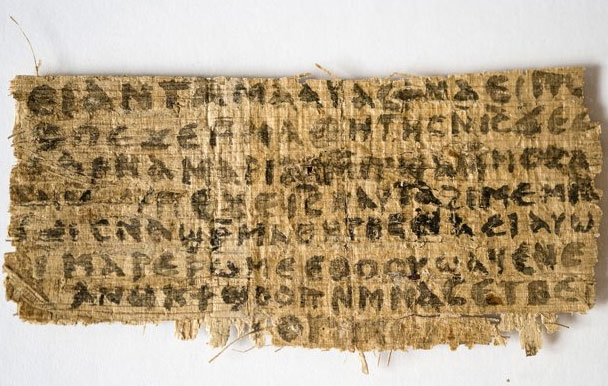The ancient piece of paper reveals the marriage of the Lord
A historian of Harvard University has just finished deciphering a piece of faded fourth-century papyrus referring to the wife of Jesus.
>>>Video: The image of Jesus appearing on the tree
An inscription in this torn piece of paper wrote, "Jesus told them," My wife . " and the following lines read: 'You will be my disciple.'
The author of this discovery, Karen King, an early Christian research historian, is the author of many books on the discoveries of new Gospels and a professor of theology at the university. Harvard. King first had access to this piece of paper in 2011 and since then she has been constantly researching it with the help of a group of other scholars.

The papyrus piece is written in Coptic language
update Jesus' talk about his wife.
According to New York Times, she and her colleagues concluded that this piece of paper was not fake and would present its findings at the International Conference on Coptic Cult Study in Rome.
This piece of paper is written in the Coptic language, used by ancient Christian missionaries in Egypt, it is unclear where it comes from and who owns this piece of paper. Scholars argue that this piece of paper can start many debates from a long time ago: Jesus married? Is Mary Magdalene his wife and he accepted her as a disciple?
King also noted that this finding should not be seen as evidence that Jesus was married. The inscription in the piece of paper was written centuries after Jesus was alive and all literary works of Christianity did not raise any doubts about the marital status of Jesus.
'This piece of paper shows that Christian followers once said that Jesus was married. There is a debate as we have known since the second century about whether Jesus was married or not , 'said Karen.
According to The Times, researchers on the papyrus and Coptic language researchers say they are convinced by the authenticity of the paper thanks to the blurring of ink on papyrus and sticky ink. paper edges. From ideas, scripts to grammar in paper is almost impossible to fake.
LiveScience said some of the words in the piece of paper are very similar to the excerpts in the Gospel of Thomas and Mary, both written in the late second century and translated into Coptic language. Professor King guessed that this piece of paper was also copied from a second-century Greek excerpt.
- Invent for ink removal on paper for 5 minutes
- Is it possible to double a sheet of paper 7 times in a row without using a hydraulic compressor?
- Ancient Egyptian women demanded benefits by marriage contracts
- Mystery of the wheel
- Recreate ancient Peruvian lord face with 3D technology
- Self-translucent printing paper, new energy-saving way
- Discovered 'dirty' vegetables and fruits with just a piece of paper
- Another human being became extinct because of the 'marriage of death' with our ancestors
- Video: Paper boat can carry people floating on the lake
- 4,000-year-old marriage contract was discovered
- Do you know: a 103-fold piece of paper would be as thick as the ... universe
- Mysterious Chinese 2,600-year-old paper armor, blocking both swords, pistols or names
 Discovered an ancient centipede fossil 99 million years old
Discovered an ancient centipede fossil 99 million years old Discovered bat-like dinosaurs in China
Discovered bat-like dinosaurs in China Discovered a 200-year-old bronze cannon of the coast
Discovered a 200-year-old bronze cannon of the coast Discover 305 million-year-old spider fossils
Discover 305 million-year-old spider fossils